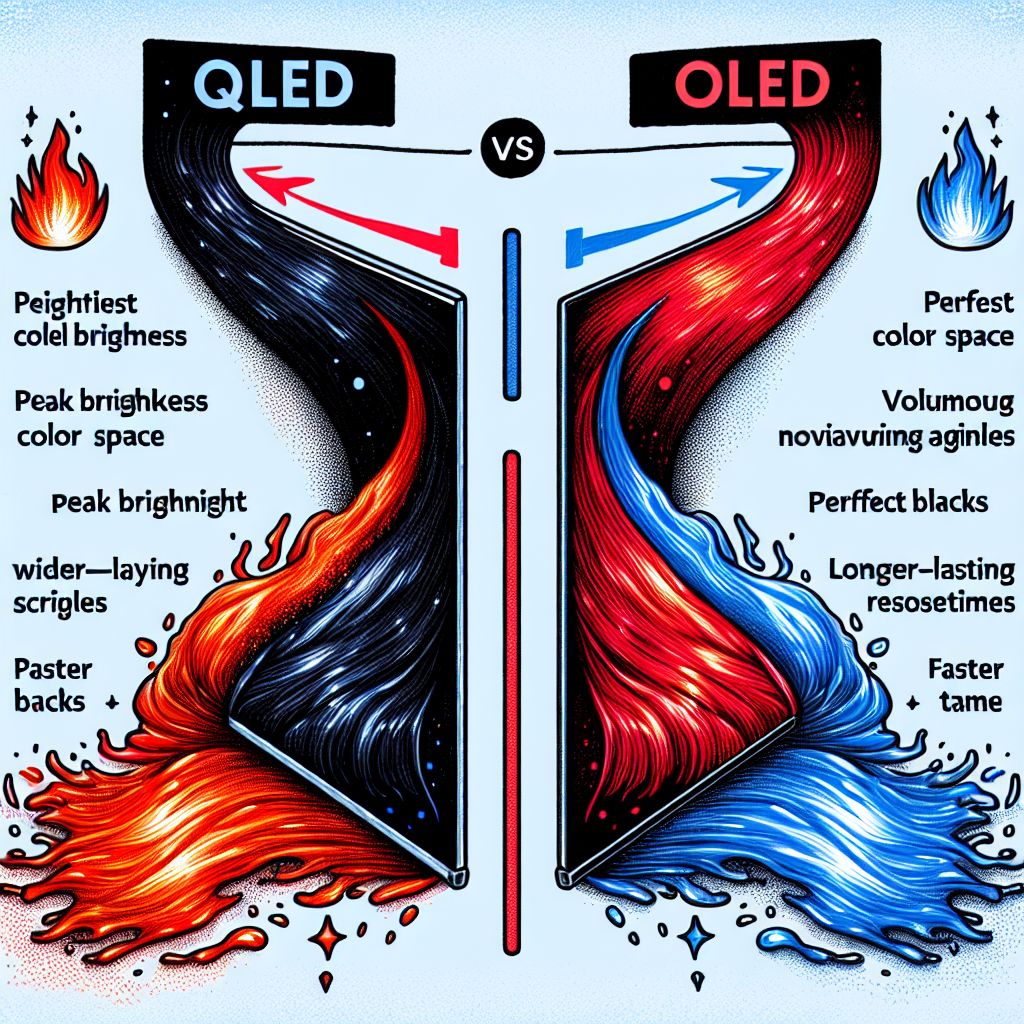Key Takeaways
- OLED TVs offer perfect black levels and excellent color accuracy, making them ideal for dark room viewing.
- QLED TVs are generally brighter and better suited for rooms with lots of ambient light.
- OLED TVs can be more expensive but provide a superior viewing experience in terms of picture quality.
- QLED TVs are often more affordable and have a longer lifespan without the risk of burn-in.
- Consider your room lighting and budget when choosing between OLED and QLED TVs.
Why OLED vs. QLED Matters for Your Viewing Experience
Choosing between OLED and QLED TVs can significantly impact your viewing experience. The technology behind these two types of displays differs greatly, affecting everything from picture quality to longevity and price. Understanding these differences will help you make the best choice for your needs.
- Picture Quality: OLED offers better contrast and color accuracy.
- Brightness: QLED is brighter, which is great for well-lit rooms.
- Longevity: QLEDs generally last longer and have no burn-in risk.
- Price: OLEDs are typically more expensive but offer premium quality.
Most importantly, the decision comes down to your personal preferences and viewing environment. Do you watch TV in a dimly lit room or a bright space? Is your budget flexible, or are you looking for the best value? These factors will guide your choice between OLED and QLED.
Overview of OLED and QLED Technologies
OLED stands for “Organic Light Emitting Diode,” a technology where each pixel emits its own light. This allows for perfect blacks and exceptional contrast because pixels can turn off completely.
QLED, on the other hand, stands for “Quantum Dot Light Emitting Diode.” It uses a layer of quantum dots to enhance the brightness and color of an LED backlit display. This technology is known for its vibrant colors and high brightness levels.
Importance of Choosing the Right TV Technology
When you’re buying a new TV, it’s crucial to choose the right technology to match your viewing habits and environment. If you love watching movies in a dark room, OLED might be your best bet. But if your living room gets a lot of sunlight, a QLED TV might perform better.
Besides that, consider the longevity and potential risks. OLEDs, while stunning in display quality, can suffer from burn-in if static images are displayed for long periods. QLEDs, however, generally have a longer lifespan without such risks.
What is an OLED TV?
OLED TVs are known for their incredible picture quality. The secret lies in their ability to produce perfect blacks and an infinite contrast ratio. This is because each pixel in an OLED screen emits its own light and can turn off completely, which is impossible for traditional LED screens.
Because of this technology, OLED TVs deliver a more immersive viewing experience with vibrant colors and stunning clarity. They’re particularly well-suited for watching movies and shows in a dark room, where their deep blacks can truly shine.
“OLED technology allows each pixel to emit its own light, providing perfect black levels and stunning contrast.”
How OLED Technology Works
OLED technology uses organic compounds that emit light when an electric current is applied. This means each pixel can turn on and off independently, allowing for precise control over color and brightness. The result is a display that can achieve true black by turning off individual pixels, creating a stark contrast with the bright colors. For more on technology comparisons, check out this comparison of VirtualBox vs. VMware.
Advantages of OLED TVs
OLED TVs offer several advantages that make them a popular choice among home theater enthusiasts. Firstly, their ability to produce perfect blacks and an infinite contrast ratio results in a more lifelike picture quality. This makes them ideal for watching movies and high-definition content.
Additionally, OLED screens have a wider viewing angle compared to traditional LED screens. This means you can enjoy consistent picture quality from almost any angle in the room. Moreover, OLED TVs are generally thinner and lighter, making them easier to mount and integrate into modern home designs.
Limitations of OLED TVs
Despite their many advantages, OLED TVs do have some limitations. One of the main concerns is the potential for burn-in. This occurs when static images are displayed for extended periods, causing permanent damage to the screen. However, with normal viewing habits, this risk is minimal. For a deeper understanding of the differences, check out this OLED vs. QLED comparison.
Another limitation is brightness. OLED TVs are generally not as bright as QLEDs, which can be a disadvantage in rooms with a lot of ambient light. Additionally, OLED TVs tend to be more expensive, which might not be suitable for budget-conscious buyers.
- Risk of burn-in with static images.
- Lower brightness compared to QLED.
- Higher price point.
Understanding these limitations will help you weigh the pros and cons of OLED technology and decide if it’s the right choice for your viewing needs.
Defining QLED TV Technology
QLED TVs are a variation of LED technology that uses quantum dots to enhance picture quality. These quantum dots are microscopic molecules that emit their own light when hit by an LED backlight. This results in brighter and more vibrant colors, making QLEDs ideal for bright rooms.
How QLED Technology Works
QLED technology involves a layer of quantum dots that sit between the LED backlight and the LCD screen. When the backlight shines through these dots, they emit light at different wavelengths, enhancing the overall color and brightness of the image. This process allows QLED TVs to achieve higher brightness levels and a wider color gamut than traditional LED TVs. For more information on related technology, explore this guide on RSS feed directories.
Advantages of QLED TVs
QLED TVs are renowned for their exceptional brightness and vibrant colors. This makes them perfect for rooms with plenty of ambient light, such as living rooms with large windows. Their ability to produce high brightness levels ensures that the picture remains vivid and clear, even in well-lit environments.
Another significant advantage of QLED TVs is their longevity. Unlike OLEDs, QLEDs do not suffer from burn-in, making them a reliable choice for households where the TV might display static images for extended periods. This durability means QLED TVs can have a longer lifespan, providing value over time.
Furthermore, QLED TVs often come at a more affordable price point compared to OLEDs. This makes them an attractive option for those looking for a high-quality viewing experience without breaking the bank. The competitive pricing of QLEDs allows more consumers to access advanced TV technology.
Limitations of QLED TVs
While QLED TVs boast several benefits, they also have limitations. One of the main drawbacks is their inability to achieve the perfect black levels that OLEDs can. Because QLEDs rely on a backlight, they cannot turn off individual pixels completely, which can lead to less contrast in dark scenes. For more insights into technological advancements, you might be interested in the latest news on the Cybertruck explosion.
Additionally, QLEDs may not offer the same viewing angles as OLEDs. As a result, picture quality can degrade when viewed from the side, which might be a concern for larger rooms where viewers are spread out.
Head-to-Head Comparison: OLED vs. QLED
When comparing OLED and QLED TVs, several factors come into play. Each technology has its strengths and weaknesses, making them suitable for different viewing environments and preferences. Understanding these differences is crucial in making an informed decision.
Let’s explore how OLED and QLED stack up against each other in terms of picture quality, brightness, longevity, and price.
Picture Quality and Color Accuracy
OLED TVs offer superior picture quality with perfect blacks and excellent color accuracy. This makes them ideal for dark room viewing, where their ability to display deep blacks enhances the overall viewing experience.
In contrast, QLED TVs provide vibrant colors and high brightness levels, which can make them stand out in bright environments. While they may not achieve the same level of black accuracy as OLEDs, QLEDs excel in delivering vivid and colorful images.
Overall, if picture quality and color accuracy are your top priorities, OLED might be the better choice. However, for those who value brightness and vibrant colors, QLED offers a compelling alternative.
Brightness and Performance in Different Lighting Conditions
QLED TVs are designed to perform exceptionally well in bright lighting conditions. Their high brightness levels ensure that images remain clear and vivid, even in rooms with lots of sunlight. This makes them a great choice for living spaces with large windows or overhead lighting.
Longevity and Risk of Burn-In
One of the significant concerns with OLED technology is the risk of burn-in. This occurs when static images are displayed for prolonged periods, leading to permanent marks on the screen. While modern OLEDs have improved in this regard, the risk still exists for users who frequently display static content.
QLED TVs, on the other hand, do not suffer from burn-in. This makes them a safer option for households where the TV might be used for gaming or displaying static images like news channels or photo slideshows. The durability of QLEDs contributes to their longer lifespan and reliability.
Price Comparison and Value for Money
When it comes to price, QLED TVs generally offer better value for money. They are often more affordable than OLEDs, making advanced TV technology accessible to a broader range of consumers. This affordability, combined with their durability, makes QLEDs a popular choice for budget-conscious buyers.
Choosing the Best TV for Your Needs
Now that we’ve explored the differences between OLED and QLED TVs, it’s time to consider which option is best suited for your needs. Several factors should influence your decision, including room lighting, budget, and long-term usage.
Consider your viewing environment. If you watch TV in a dark room and prioritize picture quality, OLED might be the ideal choice. However, if your living space is bright and you need a TV that can handle ambient light, QLED is likely the better option.
Budget is another critical factor. If you’re looking for the best value, QLED TVs offer advanced features at a more affordable price. However, if you’re willing to invest in premium picture quality, OLEDs deliver an unmatched viewing experience.
- Assess your room’s lighting conditions.
- Determine your budget and long-term usage.
- Consider the types of content you watch most frequently.
- Think about the viewing angles in your room.
Consideration for Room Lighting
Room lighting plays a significant role in determining which TV technology is best for you. OLED TVs excel in dark environments, where their ability to produce perfect blacks creates a cinematic experience. If you have a dedicated home theater room, OLED might be your best bet.
Conversely, if your living space has plenty of natural light or overhead lighting, a QLED TV’s brightness and vibrant colors will ensure that your viewing experience remains enjoyable, even during the day.
Budget Constraints
Budget constraints can also influence your decision. QLED TVs are typically more affordable, making them an attractive option for those looking to maximize their investment. If you’re on a tight budget but still want excellent picture quality, a QLED TV can offer the best of both worlds.
Future-Proofing Your Purchase
- Consider the longevity and durability of the TV technology.
- Think about the type of content you will be watching in the future.
- Evaluate the scalability and compatibility with future tech upgrades.
- Look for TVs with software update capabilities for new features.
When investing in a new TV, it’s crucial to consider future-proofing your purchase. Technology is constantly evolving, and you want to ensure that your TV can keep up with new advancements. Both OLED and QLED TVs have their merits, but it’s essential to choose one that aligns with your long-term needs.
Consider the types of content you’ll be watching. If you’re a gamer or a movie enthusiast, OLED’s superior picture quality might be worth the investment. On the other hand, if you frequently watch TV in a bright room, a QLED’s brightness could serve you better in the long run.
Also, think about the TV’s compatibility with future tech upgrades. Many modern TVs come with smart features and software update capabilities, allowing them to adapt to new technologies as they become available. This ensures that your TV remains relevant for years to come.
Lastly, don’t forget to evaluate the TV’s longevity and durability. While OLEDs offer stunning visuals, QLEDs are known for their durability and resistance to burn-in. This makes them a reliable choice for households where the TV is used extensively.
Conclusion: Final Thoughts and Recommendations
- OLED TVs are ideal for dark rooms and movie enthusiasts.
- QLED TVs excel in bright environments and offer great value.
- Consider your budget and long-term viewing habits.
- Evaluate the pros and cons of each technology before deciding.
In conclusion, both OLED and QLED TVs have their unique strengths and weaknesses. The decision ultimately depends on your specific needs and preferences. If you prioritize picture quality and watch TV in a dark room, OLED is the way to go. However, if you need a TV that performs well in bright environments and offers great value, QLED is an excellent choice.
Take the time to assess your budget and long-term viewing habits. Consider the types of content you enjoy and the lighting conditions in your viewing space. By weighing these factors, you’ll be better equipped to make an informed decision that aligns with your lifestyle.
Remember that both technologies offer exceptional viewing experiences, and the choice comes down to personal preference. Whether you choose OLED or QLED, you’re investing in a high-quality TV that will enhance your entertainment experience.
Ultimately, the best TV for you is the one that fits seamlessly into your home and meets your viewing needs. So take your time, explore your options, and make a choice that you’ll be happy with for years to come.
The Best Choice for Specific Needs
For movie enthusiasts who enjoy watching films in a dimly lit room, OLED TVs provide unparalleled picture quality with their perfect blacks and stunning contrast. They deliver a cinematic experience that truly immerses viewers in the content.
On the other hand, if you frequently watch TV in a bright room or enjoy vibrant, colorful images, a QLED TV might be more suitable. Its high brightness levels and vivid colors ensure that the picture remains clear and engaging, even in well-lit environments.
Where to Purchase Your Next TV
- Visit reputable electronics retailers like Best Buy or Amazon.
- Check out online reviews and ratings before making a purchase.
- Consider buying during sales events for potential discounts.
- Explore manufacturer websites for exclusive deals and offers.
When it comes to purchasing your next TV, there are several options to consider. Reputable electronics retailers like Best Buy and Amazon offer a wide range of OLED and QLED models, allowing you to compare features and prices easily.
Before making a purchase, it’s essential to read online reviews and ratings. This will give you insights into the performance and reliability of different TV models, helping you make an informed decision. For instance, understanding the implications of a data breach response can be crucial when evaluating smart TV security features.
Consider buying during sales events like Black Friday or Cyber Monday, as these occasions often feature significant discounts on electronics. Additionally, explore manufacturer websites for exclusive deals and offers that may not be available elsewhere.
Frequently Asked Questions
When choosing between OLED and QLED TVs, several common questions arise. Understanding the answers to these questions can help you make a more informed decision.
What is the lifespan of OLED vs. QLED TVs?
QLED TVs generally have a longer lifespan compared to OLEDs. This is because QLEDs do not suffer from burn-in, which can affect OLEDs if static images are displayed for extended periods. With proper care, both types of TVs can last for many years.
“QLED TVs are known for their durability and resistance to burn-in, making them a reliable choice for long-term use.”
It’s important to note that OLED technology has improved over the years, and the risk of burn-in has been significantly reduced. However, if longevity is a primary concern, QLEDs might be the safer option.
Can OLED TVs suffer from burn-in?
Yes, OLED TVs can suffer from burn-in if static images are displayed for prolonged periods. This occurs when certain pixels wear out faster than others, leaving a permanent mark on the screen. However, with normal viewing habits and varied content, the risk of burn-in is minimal.
Are QLED TVs better for bright rooms?
Yes, QLED TVs are better suited for bright rooms due to their high brightness levels and vibrant colors. They can maintain picture clarity and vividness even in well-lit environments, making them an excellent choice for living spaces with lots of natural light.
In contrast, OLED TVs excel in darker environments, where their ability to produce perfect blacks enhances the overall viewing experience. Therefore, the choice between the two depends on your room’s lighting conditions.
Which is more energy-efficient: OLED or QLED?
OLED TVs are generally more energy-efficient than QLEDs because they do not require a backlight. Each pixel in an OLED display emits its own light, consuming less power compared to QLEDs, which rely on an LED backlight to illuminate the screen.
Do OLED TVs offer better color accuracy?
Yes, OLED TVs offer better color accuracy due to their ability to produce true blacks and a wider color gamut. This results in more lifelike images with precise colors and contrast, making them ideal for watching movies and high-definition content.
“OLED’s superior color accuracy and contrast make it the preferred choice for those who prioritize picture quality.”
While QLEDs provide vibrant colors and excellent brightness, they may not achieve the same level of color accuracy as OLEDs. However, both technologies offer impressive picture quality, and the choice ultimately depends on personal preferences and viewing conditions.
In conclusion, both OLED and QLED TVs have their unique advantages and limitations. For a detailed comparison of features and performance, understanding these differences and considering your specific needs can help you make an informed decision that enhances your viewing experience.
Free Press Release Daily & Weekly Roundup
Your #1 Source for Breaking | Break Out | Trending | Viral Broadcasts


















One thought on “Best OLED vs. QLED TV Comparison, Differences & Guide”